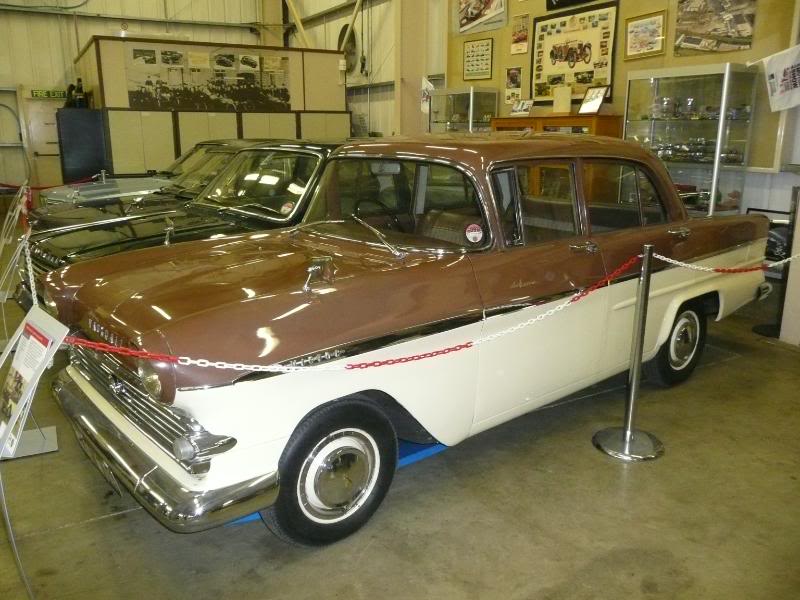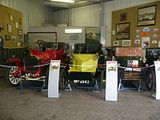
Vauxhall’s Heritage Collection is not usually open to the public. However, in support of a national day encouraging us all to drive our classics, the doors were flung open on Sunday. I decided to extend my journey to Heathrow by a little bit and go and see what treasures are denied to us, by paying a visit. Firstly, it’s quite obvious why this is not a museum, open on a regular basis. What I found, in a building hidden behind Griffin House, Vauxhalls’ UK HQ, is a building that resembles more of a workshop and storage shed, but lining the walls are all sorts of display memorabilia, and surrounding the display cars were some nicely printed up boards with a little of the history of each vehicle.
The cars, however, were somewhat crammed in, so viewing them properly was difficult, even without making allowance for the large throngs of people who had also decided to come and inspect. Having said that, a good range of cars from Vauxhall’s past is there to be seen, many of them were once common sights on our roads, but now rarely in evidence. Vauxhall Motors goes back to 1903. This car, the 45th ever built, a 5hp single cylinder car is believed to be the oldest surviving 4 seater from the range, and had a top speed of a heady 20 mph!
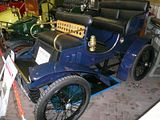 New models followed in quick succession, as these cars show.
New models followed in quick succession, as these cars show.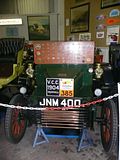
 By 1909, the desire for a sporting image was apparent, though this offering would hardly look like it achieved the goal! This B-type developed 16hp from its 2315cc engine and had a top speed of 50 mph.
By 1909, the desire for a sporting image was apparent, though this offering would hardly look like it achieved the goal! This B-type developed 16hp from its 2315cc engine and had a top speed of 50 mph.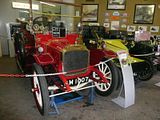 It was with the Prince-Henry model in 1913 that Vauxhall really established their credentials for sustained high speed running. The follow on cars, the 30/98 models from the early 1920s further reinforced this new found prowess. A very high percentage of these cars survive even to this day, which is fair indication of the esteem in which they have always been held. This 1924 M Type 14/40 Tourer was not aimed at the sporting market, but did have a number of design innovations such as a vacuum fed fuel system, to enable easier starting.
It was with the Prince-Henry model in 1913 that Vauxhall really established their credentials for sustained high speed running. The follow on cars, the 30/98 models from the early 1920s further reinforced this new found prowess. A very high percentage of these cars survive even to this day, which is fair indication of the esteem in which they have always been held. This 1924 M Type 14/40 Tourer was not aimed at the sporting market, but did have a number of design innovations such as a vacuum fed fuel system, to enable easier starting.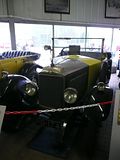 During the 1920s and 30s, Vauxhall offered a range of cars aimed at catering for the family motorist. This R Type 20/60 was the first car produced after General Motors had acquired Vauxhall. 9 different body options were available, to complement the 6 cylinder engine. 4228 examples of this car were made between 1928 and 1930
During the 1920s and 30s, Vauxhall offered a range of cars aimed at catering for the family motorist. This R Type 20/60 was the first car produced after General Motors had acquired Vauxhall. 9 different body options were available, to complement the 6 cylinder engine. 4228 examples of this car were made between 1928 and 1930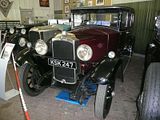
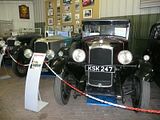
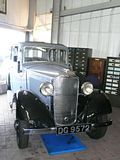 This limousine, dating from the late 1930s, received a special body, and is believed now to be the only survivor of its type.
This limousine, dating from the late 1930s, received a special body, and is believed now to be the only survivor of its type.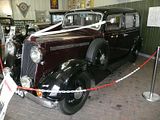
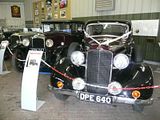 Once production resumed after the Second World War, Vauxhall concentrated on a range of family cars. Mainstay of the range from its launch in 1957 was the Victor, a popular family saloon and estate car range, which was regularly updated with a new model every 4 years. An example of each generation was on display.Victor FA Super
Once production resumed after the Second World War, Vauxhall concentrated on a range of family cars. Mainstay of the range from its launch in 1957 was the Victor, a popular family saloon and estate car range, which was regularly updated with a new model every 4 years. An example of each generation was on display.Victor FA Super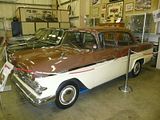 Victor FB DeLuxe Estate
Victor FB DeLuxe Estate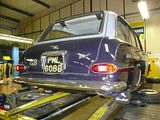
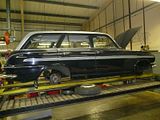 Victor FC 101
Victor FC 101 Ventora FD – this was created by dropping the 3.3 litre inline 6 engine into the Victor, which made for quite a rapid express in its day
Ventora FD – this was created by dropping the 3.3 litre inline 6 engine into the Victor, which made for quite a rapid express in its day Victor FE 2300S – this was a limited edition model dating from 1975.
Victor FE 2300S – this was a limited edition model dating from 1975.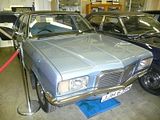 Larger brother to the Victor range was the Cresta. This PA Model was launched in 1957, and with its gawdy colour schemes and large amounts of chrome trim was much in demand by those who could afford it. The PB model, revealed for 1962, was somewhat more restrained.
Larger brother to the Victor range was the Cresta. This PA Model was launched in 1957, and with its gawdy colour schemes and large amounts of chrome trim was much in demand by those who could afford it. The PB model, revealed for 1962, was somewhat more restrained.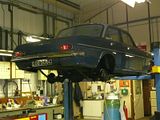 The final iteration, the PC, came in 1966, and was quickly augmented with a far more luxurious version, called the Viscount. This is one of the last off the line, dating from 1971.
The final iteration, the PC, came in 1966, and was quickly augmented with a far more luxurious version, called the Viscount. This is one of the last off the line, dating from 1971.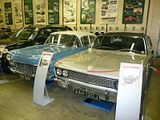 Vauxhall introduced an additional model line in 1963, when the HA Viva first appeared. Despite initially only being offered in Standard and De Luxe models, it was an instant hit.
Vauxhall introduced an additional model line in 1963, when the HA Viva first appeared. Despite initially only being offered in Standard and De Luxe models, it was an instant hit. The HB model arrived in 1966 and was even more of a success than its predecessor, taking early advantage of the fact that its principal market competitor, the Ford Escort, was 16 months later in arriving on the market..
The HB model arrived in 1966 and was even more of a success than its predecessor, taking early advantage of the fact that its principal market competitor, the Ford Escort, was 16 months later in arriving on the market..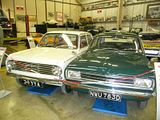 Also dating from 1966 was this. the XVR Concept Car.
Also dating from 1966 was this. the XVR Concept Car. Until 1975, Vauxhall and Opel, although both owned by General Motors, developed completely separate model ranges. That all changed with the first of the global “T” cars, which was manifest in the UK as the Chevette. What started out as a simple 3 door hatchback quickly grew into a full range of saloons, estate cars, a van, and then something which could be adapted into a very successful rally car.
Until 1975, Vauxhall and Opel, although both owned by General Motors, developed completely separate model ranges. That all changed with the first of the global “T” cars, which was manifest in the UK as the Chevette. What started out as a simple 3 door hatchback quickly grew into a full range of saloons, estate cars, a van, and then something which could be adapted into a very successful rally car.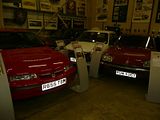

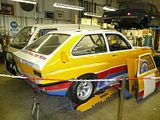 The next shared effort was the Cavalier. From rather tentative beginnings at launch at the Earls Court Motor Show in October 1975, this car quickly became a formidable rival to the Ford Cortina. Here is a top of the range 2000GLS from 1979
The next shared effort was the Cavalier. From rather tentative beginnings at launch at the Earls Court Motor Show in October 1975, this car quickly became a formidable rival to the Ford Cortina. Here is a top of the range 2000GLS from 1979
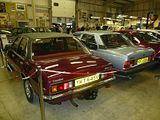 With the move to front wheel drive in 1981, and the adoption of brand new engines which developed far more power than their competitors, the Cavalier became a clear class leader. This Helios Blue 1.6L model is typical of the rep’s favourite in the early 1980s.
With the move to front wheel drive in 1981, and the adoption of brand new engines which developed far more power than their competitors, the Cavalier became a clear class leader. This Helios Blue 1.6L model is typical of the rep’s favourite in the early 1980s.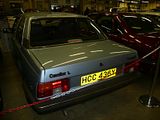 A more rounded approach to the styling was evident when the third generation model was launched in 1988. A bewildering array of models, including more diesels, a GSi sports version and the smoothness of the 2.5 litre V6 made for a comprehensive range. This is one of the last 2.5 V6 cars. Even without the well-publicised savaging from Jeremy Clarkson, the Vectra never quite captured the nation in the way that its predecessor had managed. This car is the last Vectra made at Luton in 2002.
A more rounded approach to the styling was evident when the third generation model was launched in 1988. A bewildering array of models, including more diesels, a GSi sports version and the smoothness of the 2.5 litre V6 made for a comprehensive range. This is one of the last 2.5 V6 cars. Even without the well-publicised savaging from Jeremy Clarkson, the Vectra never quite captured the nation in the way that its predecessor had managed. This car is the last Vectra made at Luton in 2002.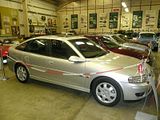 Based on the Cavalier, but clothed in one of the most aerodynamic bodies available at the time, the Calibra found instant success. This model is an SE9, one of the last cars made, and which spent its early life in Vauxhall’s press fleet.
Based on the Cavalier, but clothed in one of the most aerodynamic bodies available at the time, the Calibra found instant success. This model is an SE9, one of the last cars made, and which spent its early life in Vauxhall’s press fleet.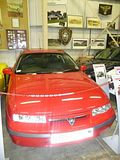 Since the 1980s, Vauxhall’s medium sized hatch offering has been the Astra. After a rather square and boxy first generation model, the second cars, launched in 1984 were very rounded and looked like nothing else on the market at the time. This GTE 16V is such an example.
Since the 1980s, Vauxhall’s medium sized hatch offering has been the Astra. After a rather square and boxy first generation model, the second cars, launched in 1984 were very rounded and looked like nothing else on the market at the time. This GTE 16V is such an example. This Astra 4S was undergoing development as a new and potent rally weapon, but after the tragedy that brought to an end the era of the Group B cars, the project proceeded no further.
This Astra 4S was undergoing development as a new and potent rally weapon, but after the tragedy that brought to an end the era of the Group B cars, the project proceeded no further.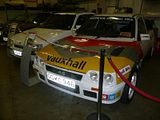 The third generation Astra arrived in 1991, and was on the market for 7 years, selling in huge volume.
The third generation Astra arrived in 1991, and was on the market for 7 years, selling in huge volume.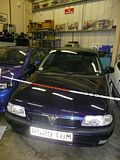 Two of the most exciting large Vauxhalls of the recent past were on display outside. The Lotus Carlton, offered for the eye-watering price of £48,000, in 1990, was at the time the fastest four door saloon on the market. Coupled with its Opel brother, less than 1000 were made.
Two of the most exciting large Vauxhalls of the recent past were on display outside. The Lotus Carlton, offered for the eye-watering price of £48,000, in 1990, was at the time the fastest four door saloon on the market. Coupled with its Opel brother, less than 1000 were made. Spiritual successor was the Monaro, a Vauxhall-ed version of a Holden, and offered for a bargain price, considering its performance and talents.
Spiritual successor was the Monaro, a Vauxhall-ed version of a Holden, and offered for a bargain price, considering its performance and talents.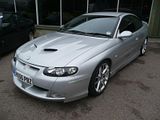 Vauxhall also had another recent initiative working with Lotus, and the result was this, the VX220.
Vauxhall also had another recent initiative working with Lotus, and the result was this, the VX220.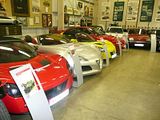 A number of owners brought their historic Vauxhalls along as well, and these were on show outside, and added further variety. Some additional Viva cars were on show. The HB model GT could be seen as the sort of precursor of the hot hatch, though the reality is it only ever sold in small numbers.
A number of owners brought their historic Vauxhalls along as well, and these were on show outside, and added further variety. Some additional Viva cars were on show. The HB model GT could be seen as the sort of precursor of the hot hatch, though the reality is it only ever sold in small numbers.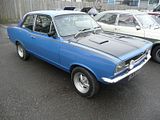
 This HC model was from the middle of the model’s nearly 10 year production life.
This HC model was from the middle of the model’s nearly 10 year production life.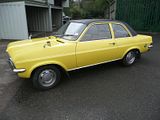 In the Victor range, the VX4/90 was the sporting model. Though “sporting” would appear a relative term by today’s standards!
In the Victor range, the VX4/90 was the sporting model. Though “sporting” would appear a relative term by today’s standards!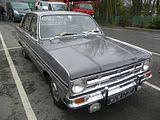
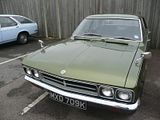 By the FE model, the Victor had grown from being a medium sized car, to a large one
By the FE model, the Victor had grown from being a medium sized car, to a large one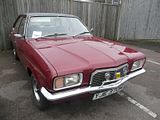 Further examples of the Chevette and the first generation Cavalier were here.
Further examples of the Chevette and the first generation Cavalier were here.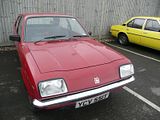
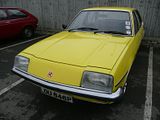 The Royale was a close twin of the Opel Senator and Monza, launched in 1978. Whilst the Opels have a certain following, the Vauxhalls are very rare now, as they only sold in small numbers:
The Royale was a close twin of the Opel Senator and Monza, launched in 1978. Whilst the Opels have a certain following, the Vauxhalls are very rare now, as they only sold in small numbers: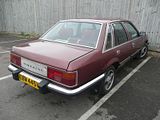
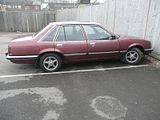 Not a Vauxhall, but worthy of a display place was this Opel GT. Promoted as a mini-Corvette, the car was never officially offered in the UK, but a few have found their way onto these shores over the years.
Not a Vauxhall, but worthy of a display place was this Opel GT. Promoted as a mini-Corvette, the car was never officially offered in the UK, but a few have found their way onto these shores over the years. So, an interesting visit. The Collection is usually opened once a year, to coincide with the Luton Festival of Transport, held in June. It’s worth a look if you are in the area. Just don’t expect a polished museum experience!
So, an interesting visit. The Collection is usually opened once a year, to coincide with the Luton Festival of Transport, held in June. It’s worth a look if you are in the area. Just don’t expect a polished museum experience!2009-12-28 10:23:48















































